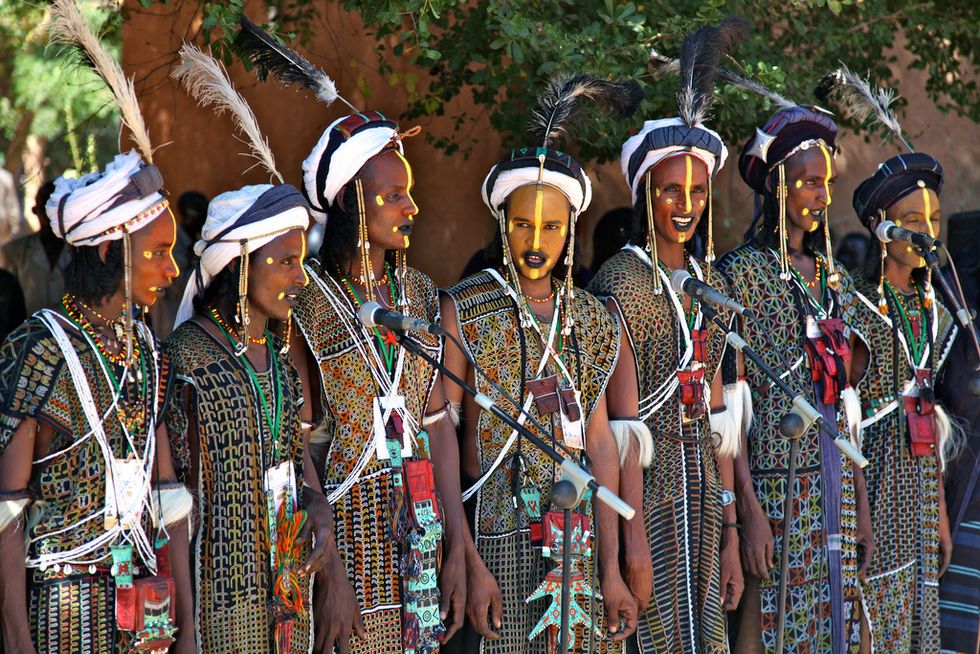Culture is found in all human societies and can be shown through numerous forms, including expressive forms such as art, music, dance, ritual, and religion.
The Sub-Saharan African people group called the Fulani are nomadic peoples who have been influential in regional politics, economics, and histories throughout West African culture for centuries. Music and dance are extremely important to the culture of the Fulani people. The Fulani have a rich musical culture and play a variety of traditional instruments. Their collection of instruments includes drums, hoddu, and riti, in addition to vocal music. The hoddu is a plucked, skin-covered lute similar to a bajo, and the riti is a one-string bowed instrument that is similar to a violin. Zaghareet, also known as ululation, is a popular form of vocal music formed by rapidly moving the tongue sideways and making a sharp, high sound. However, the music of the Fulani is as varied as its people. The numerous sub-groups all maintain unique repertoires of music and dance.
The songs and dance of the Fulani reflect their traditional life and are specifically designed for each individual occasion in their life. Music plays an integral role in the celebration of life's many rituals and accompanies everyday activities. Music is frequently played during all occasions, including herding cattle, working in the field and preparing food. Music is extremely important to the village life cycle with field cultivation, harvest and winnowing of millet performed to the rhythm of the songs and drums.
African dance is a performing art that is deeply woven into the social fabric of Africa and generally involves aspects of music and theatre as well as rhythmic bodily movement. Dancers use many techniques, including symbolic gestures, masks, costumes, body paint, and props to communicate. Dances can range from simple to incredibly complex. It is used to express emotions and is not limited to just the dancers; spectators are often encouraged to join in.
The Gerewol is an annual courtship ritual competition held by the Fulani people. In the competition, young men dress in elaborate costumes and traditional face painting. They gather in lines to dance and sing, with the goal of vying for the attention of young, marriageable women.
The Gerewol festival is a beauty pageant, in which young, available males are judged by young, marriageable females.
Although it may lead to nothing more than a playful flirtation or night of love, it may turn into a serious marriage proposal. However, there is no social stigma associated with the selection, as a young woman's virginity is not a serious concern for the Fulani people group.
The male beauty ideal of the Fulani stresses tallness, white eyes, and white teeth, and as a result, the men will often roll their eyes and show their teeth to emphasize these characteristics. The men paint their faces yellow and red, representing happiness and power and strength, which are important themes in their warrior dances. The colors come from clay and plant extracts, which are also used to add dotted patterns on their faces and the eyes of the men are contoured with black powder, and their lips are colored blue or black to contrast their teeth. The men wear exquisite jewelry made from leather, brass, or copper, and wear beaded headdresses or turbans. A large feather is often stuck into their outfit, to imitate the long-legged white cattle egret, which is a bird that grows long plumes and offers a display of feathers during its courtship.
Tribal Beauty Pageant -- for Men | National Geographicwww.youtube.com
The Gerewol occurs each year at the Southern edge of the Sahara, where the nomadic cattle herders meet before they disperse south for their dry-season pastures. The most famous gathering point for the Gerewol is In-Gall in northwest Niger. The dance event of the Gerewol is called the Yaake, while other elements, including bartering over dowry and camel races between suitors make up the week-long Gerewol. Music and line dancing are traditional of the Fulani people; it is characterized by group singing and accompanied by clapping, stomping, and bells.
This festival is one of the more famous examples of repeating, hypnotic and percussive choral traditions, often accompanied by a swaying line dance in which the men interlink arms and rise and fall on their toes. The competitions involve the dressed up young men dancing the Yaake in a line facing the young women. They will sometimes dance repeatedly over a seven-day period and for hours in the desert sun. The suitors will come to the women to prove their interest, stamina, and attractiveness, and often drink a fermented bark concoction to enable them to dance for long periods, however, it has a hallucinogenic effect on those who drink it. During their dance, the men will interlink arms and stretch on their toes to seem as tall as possible while chanting songs. They will move shoulder to shoulder, forward and backward, stomp their feet, clap their hands and ring bells attached to their ankles.
Dance has always been a crucial element of life in West African culture; binding together communities. It also helps individuals understand their role in relation to the community.
Unlike in the United States, the women in the Fulani tribe hold such an important role that their vision of male beauty determines who is going to be married and join the family. I think that the United States should start listening and learning that our opinion of beauty is just as important as what men have to say.























